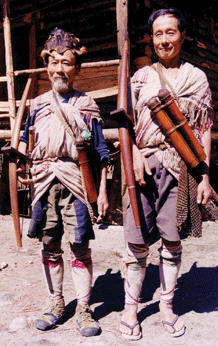Almost Gone: The Tarong of Burma’s Far North
A unique ethnic group with ties to Tibet is rapidly vanishing from a remote region of northern Burma
THE last traces of the Tarong people of the Adung Long River Valley in northernmost Kachin State are fast disappearing from this remote corner of Burma.
The Tarong are a remnant of the only known pygmy tribe of Southeast Asia, and in the absence of a written history, their origin is somewhat obscure. But it is widely accepted that they are a people of Mongolian stock who, together with other regional ethnic groups, migrated south and settled in the upper reaches of the sources of the Irrawaddy River.
It was the famous British botanist Frank Kingdon-Ward who “discovered” the Tarong during one of his many expeditions in the region in 1938 and mentioned them in his book Burma’s Icy Mountains, published in 1949. He called them the “Duru” and described them unflatteringly as “one of nature’s unsuccessful experiments.”
 |
| A mixed Tarong-Htalu man,left, and his friend, a Htalu. (Photo: Wolfgang H Trost) |
Isolated by snow and ice for most of the year and accessible only by a treacherous footpath, the Tarong had little if any contact with the outside world, and this is still the case today.
According to a survey report produced in the mid-1960s, there were 69 Tarongs living at that time in the villages of Aroomdam (now called Hkrawng) and Thalahtu in the Adung Long Valley. Even then, not all were pureblooded Tarong, and in more recent years, there has been further mixing with ethnic Htalu neighbors, who also live in both villages and who comprise a sub-group of the predominant regional group, the Rawang.
They are all neighbors of the Tibetans living in the next village north, Tahawndam, but for reasons that most likely lie in their history of being enslaved by Tibetans in the past, the Tarongs seldom interact with them. Slavery continued in the area until the 1950s, when the Communist Chinese government finally outlawed the practice.
According to their oral history, the Tarong living in the Adung Long Valley are mainly descendants of three brothers and their families who migrated sometime in the late 1800s from the main base of their tribe, nowadays called Drung, in the Drung (Tarong) River Valley on the Tibetan side of the high mountains that form the border with Burma.
The original Tarong settlers in Burma came from the village of Longdammarea, and the reasons for their migration are not entirely clear, although according to local legend, they left their home in the course of violent conflict with their Tibetan neighbors.
In any case, the Tarongs (or Drungs, as they are known in Tibet) had a long tradition of crossing over the Thala L’ka Pass in the summer to hunt or search for precious medicinal roots, bulbs and herbs. Many also made the trip to find brides among the Thalanams, a subgroup of the Htalus.
After this migration, the Tarongs in Burma stayed in regular contact with their relatives across the mountains and even brought over brides from their former home. But all this came to an end in 1950, when one of several major regional earthquakes made further crossings of the mountain range impossible.
It was then that the Tarong of the Adung Long Valley became an isolated group, and it is in the ensuing circumstances that we can find the reasons for their probable extinction as a distinct ethnic group in Burma, but not in Tibet.
The Tarong’s traditional way of life remained largely unchanged until quite recently. Their main sources of sustenance are cereals such as millet, maize and another local grain known as phantha, grown using a crude form of slash and burn farming, supplemented by some gardening of pulses. They also gather food almost daily and occasionally hunt in the nearby forests, mainly for musk or barking deer, as well as mountain goats.
Animal husbandry was largely unknown until it was adopted in recent years as a result of cohabiting with the Htalu-Rawangs. Now they raise chickens, ducks and pigs. They also keep small numbers of mithun, a kind of semi-wild cattle.
1 | 2 next page »
